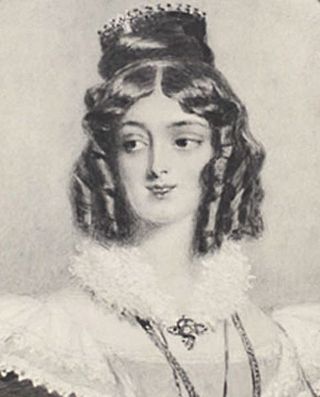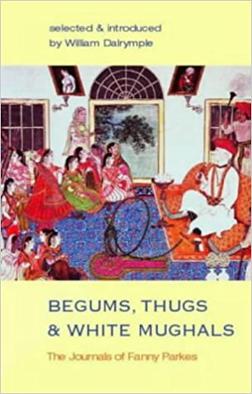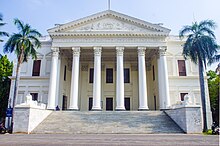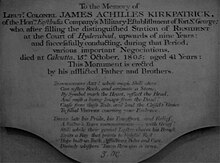
Bahadur Shah II (born Mirza Abu Zafar Siraj-ud-din Muhammad, usually referred to by his poetic title Bahadur Shah Zafar, was the twentieth and last Mughal emperor and a Hindustani poet. He was the second son and the successor to his father, Akbar II, who died in 1837. He was a titular Emperor, as the Mughal Empire existed in name only and his authority was limited only to the walled city of Old Delhi. Following his involvement in the Indian Rebellion of 1857, the British deposed him and exiled him to Rangoon in British-controlled Burma in late 1858, after convicting him on several charges. The title of Empress of India was subsequently assumed by Queen Victoria.

William Benedict Hamilton-Dalrymple is an India-based Scottish historian and art historian, as well as a curator, broadcaster and critic. He is also one of the co-founders and co-directors of the world's largest writers' festival, the annual Jaipur Literature Festival. He is currently a Visiting Fellow at All Souls College, Oxford.

Major-General Sir David Ochterlony, 1st Baronet, GCB was a Bengal Army officer who served as the British resident to the Mughal court at Delhi. Born in Boston, Massachusetts, he spent most of his life on the Indian subcontinent in the service of the East India Company, seeing action in numerous conflicts.

Joanna Nobilis Sombre, popularly known as Begum Samru, a convert Catholic Christian, started her career as a nautch (dancing) girl in 18th century India, and eventually became the ruler of Sardhana, a small principality near Meerut. She was the head of a professionally trained mercenary army, inherited from her European mercenary husband, Walter Reinhardt Sombre. This mercenary army consisted of Europeans and Indians. She is also regarded as the only Catholic ruler in Northern India, as she ruled the principality of Sardhana in 18th- and 19th-century India.

The Bibi Ka Maqbara is a tomb located in the city of Aurangabad in the Indian state of Maharashtra. It was commissioned in 1660 by the Mughal emperor Aurangzeb's son prince Azam Shah in the memory of his loving mother Dilras Banu Begum. It bears a striking resemblance to the Taj Mahal, the mausoleum of Aurangzeb's mother, Mumtaz Mahal and that is why it is also called the Taj of the Deccan. Aurangzeb was not much interested in architecture though he had commissioned the small, but elegant, Moti Masjid at Delhi. Bibi Ka Maqbara is the second largest structure that Aurangzeb has built, the largest being the Badshahi Mosque.

Zeb-un-Nissa was a Mughal princess and the eldest child of Emperor Aurangzeb and his chief consort, Dilras Banu Begum. She was also a poet, who wrote under the pseudonym of "Makhfi".
Mercenaries in India were fighters, primarily peasants, who came from India and abroad, to fight for local rulers in India in the medieval period. This mercenary work became an important source of income for some communities.

Katherine Aurora "Kitty" Kirkpatrick was a British woman of Anglo-Indian descent best known as a muse of the Scottish philosopher Thomas Carlyle. Born in India to a British father and an Indian mother, Kirkpatrick moved to England at a young age. She met Carlyle and served as his muse for several of his novels. Kirkpatrick's story has been the subject of renewed interest by 21st-century historians, most notable William Dalrymple.

Begums, Thugs and White Mughals: The Journals of Fanny Parkes is a 2002 historical travel book based on the journals of Fanny Parkes and edited by William Dalrymple.

Khairatabad is a neigbbourhood in Hyderabad, Telangana, India. It is a mandal in the Secunderabad Revenue division of Hyderabad District. This is a Zone in the Greater Hyderabad Municipal Corporation. There are five circles in this zone namely Mehdipatnam (12), Karwan (13), Goshamahal (14), Khairatabad (17) and Jubilee Hills (18). There are four wards under this Khairatabad circle, they are Khairtabad (91), Somajiguda (97), Ameerpet (98) and Sanathnagar (100).

Lieutenant-Colonel James Achilles Kirkpatrick was an East India Company officer and diplomat who served as the Resident at Hyderabad Deccan from 1798 until 1805. Kirkpatrick also ordered the construction of the Koti Residency in Hyderabad, which has since come to serve as a major tourist attraction.

Koti Residency or British Residency or "Hyderabad Residency" is an opulent mansion built by James Achilles Kirkpatrick in the princely state of Hyderabad. Kirkpatrick was British Resident of Hyderabad between 1798 and 1805. Today it is part of the Osmania University College for Women and has been converted into a museum. It can be visited with prior online booking.

St. John's Church, originally a cathedral, was among the first public buildings erected by the East India Company after Kolkata (Calcutta) became the effective capital of British India. It is located at the North-Western corner of Raj Bhavan, and served as the Anglican Cathedral of Calcutta till 1847, when the see was transferred to St. Paul's Cathedral. Construction of the building, modelled on St Martin-in-the-Fields of London, started in 1784, with Rs 30,000 raised through a public lottery, and was completed in 1787. The land the church stands on was gifted by Maharaja Nabo Kishen Bahadur of Sobhabazar. It is the third oldest church in the city, next to the Armenian Church of the Holy Nazareth and the Old Mission Church.
Zubdat-un-Nissa Begum was a Mughal princess, the third daughter of Emperor Aurangzeb and his wife Dilras Banu Begum.
Badshah Begum she was born during the reign of her great-great-grandfather Moghul Emperor Aurangzeb Alamgir, was from 8 December 1721 to 26 April 1748 as the first wife and chief consort of the Mughal emperor Muhammad Shah. She is popularly known by her title Malika-uz-Zamani which was conferred upon her by her husband, immediately after their marriage.
Ruqaiya Sultan Begum was the first wife and one of the chief consorts of the third Mughal emperor, Akbar.
Sir Henry Russell, 2nd Baronet, was an English diplomat and landowner.

William Kirkpatrick (1754–1812) was an East India Company officer, diplomat and orientalist active in Colonial India during the period of Company rule.
Begum Badar un Nissa Akhtar was an Indian social reformer and educator from Cuttack, Odisha. She is known for challenging the stringent and orthodox societal norms and for encouraging and enabling Muslim girls to receive formal and skill based education from behind the purdah back in the early 20th century. Begum herself was formally educated and hence she took up a job as a teacher in Cuttack to educate young girls. She worked to promote female education and to abolish gender discrimination and gender injustice in the field of education. She is regarded as one among the first female teachers and educationists of modern British Odisha. The Badar un nissa Assembly hall at Sayeed Seminary is named after her.
Mubarak Begum, was an Indian tawaif (courtesan) and thirteenth wife of David Ochterlony, the first British Resident to the Mughal court at Delhi.















